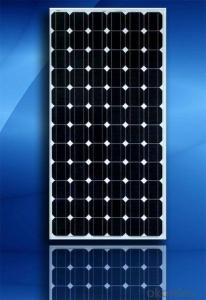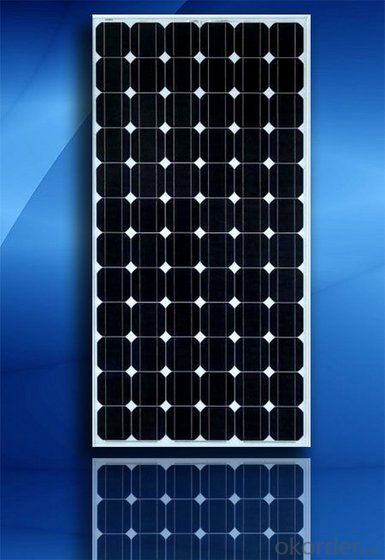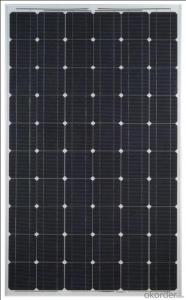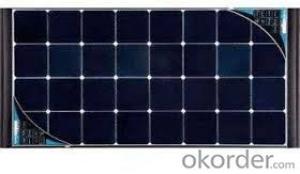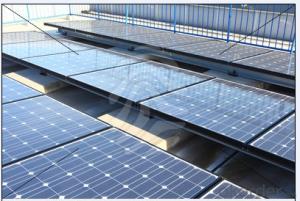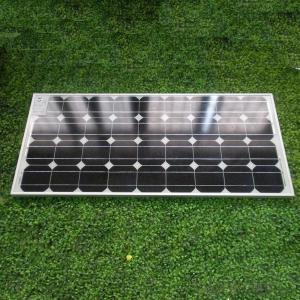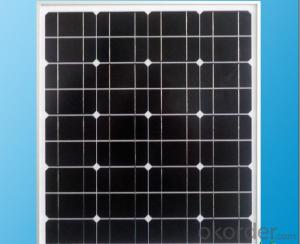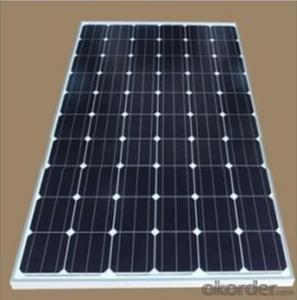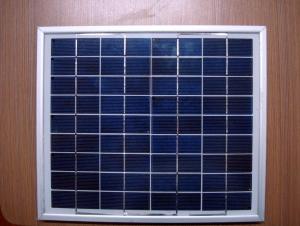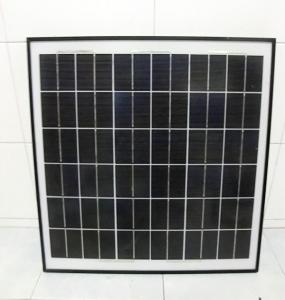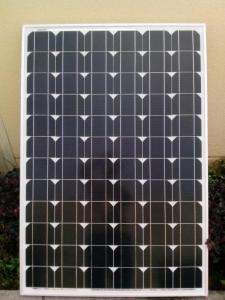Hot Sale 250W Monocrystalline Solar Panels for Car Charging with 25 Year Warranty CNBM
- Loading Port:
- Qingdao
- Payment Terms:
- TT OR LC
- Min Order Qty:
- 10 set
- Supply Capability:
- 300000 set/month
OKorder Service Pledge
OKorder Financial Service
You Might Also Like
Monocrystalline Solar Panel with 250W


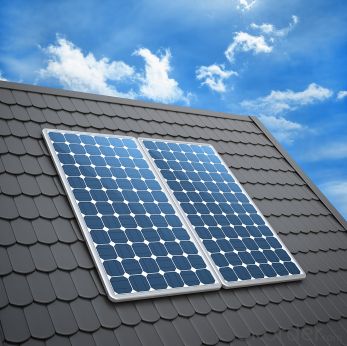
Monocrystalline Solar Modules
We offers a range of small, medium and large monocrystalline solar modules, designed for a range of requirements.
Specifications
Tolerance | +/- 3% |
Cell | Monocrystalline silicon solar cells |
N0. of Cells | 72 (12 x 6) |
Dimension of Modules (mm) | 1581 x 809 x 40 |
Weight (kg) | 15.5 |
Limits:
Operating Temperature | -40~+85? |
Storage Temperature | -40~+85? |
Maximum System Voltage | 1000 VDC max. |
Hail Impact | Diameter of 28mm with impact speed of 86km/h |
Temperature and Coefficients:
NOCT | 48C+/-2? |
Voltage temperature coefficient (%/K) | -0.34 |
Current temperature coefficient (%/K) | 0.09 |
Power temperature coefficient (%/K) | -0.37 |
Characteristics:
Model: | SGM-160D | SGM-165D | SGM-170D |
Max-power voltage Vmp (V) | 34.5 | 35.4 | 35.8 |
Max-power current Imp (A) | 4.64 | 4.66 | 4.75 |
Open-circuit voltage Voc (V) | 41.75 | 43.6 | 43.32 |
Short-Circuit Current Isc (A) | 5.32 | 5.08 | 5.38 |
Max-power Pm(W) | 160 | 165 | 170 |
Model: | SGM-175D | SGM-180D | SGM-185D |
Max-power voltage Vmp (V) | 36.1 | 36.2 | 36.2 |
Max-power current Imp (A) | 4.85 | 4.97 | 5.11 |
Open-circuit voltage Voc (V) | 43.68 | 43.8 | 44.8 |
Short-Circuit Current Isc (A) | 5.49 | 5.48 | 5.51 |
Max-power Pm(W) | 175 | 180 | 185 |
STC: Irradiance 1000W/m2, Module temperature 25?, AM=1.5
Monocrystalline Solar Panels Specifications Range
Maximum Power (Pm) | Dimension | Weight | Operating Voltage (Vmp) | Operating Current (Imp) | Open Circuit Voltage (Voc) | Short Circuit Current (Isc) |
3W | 158x241x25mm | 0.5kg | 8.5V | 0.36A | 10.5V | 0.4A |
4W | 308x166x25mm | 0.77kg | 8.5V | 0.47A | 10.5V | 0.54A |
4W | 308.x166x25mm | 0.77kg | 16.8V | 0.24A | 21V | 0.27A |
5W | 296x215x25mm | 0.3kg | 16.8V | 0.48a | 21V | 0.54A |
10W | 286x406x25mm | 1.5kg | 16.8V | 0.59A | 21V | 0.66A |
12W | 286x406x25mm | 1.5kg | 16.8V | 0.71A | 21V | 0.8A |
14W | 286x541x25mm | 2kg | 16.8V | 0.83A | 21V | 0.96A |
16W | 286x541x25mm | 2kg | 17.2V | 0.93A | 21.5V | 0.99A |
18W | 296x541x25mm | 2.4kg | 18.8V | 1.07A | 21V | 1.2A |
20W | 296x641x25mm | 2.4kg | 17.2V | 1.15A | 21.5V | 1.24A |
24W | 541x451x25mm | 3.15kg | 16.8V | 1.14A | 21V | 1.56A |
26W | 541x451x25mm | 3.15kg | 17.2V | 1.51A | 21.5V | 1.63A |
30W | 296x966x25mm | 3.85kg | 16.8V | 1.78A | 21V | 2.03A |
36W | 541x641x35mm | 4.7kg | 16.8V | 2.14a | 21V | 2.4A |
40W | 541x641x35mm | 4.7kg | 17.2V | 2.33A | 21.5V | 2.5A |
55W | 1057x457x35mm | 6.6kg | 17.6V | 3.12A | 21.6V | 3.3A |
70W | 546x1196x35mm | 8.5kg | 16.8V | 4.15A | 21V | 4.7A |
75W | 546x1196x35mm | 8.5kg | 17.2V | 4.36A | 21.5V | 4.8A |
80W | 546x1196x35mm | 8.5kg | 17.6V | 4.55A | 21.6V | 4.9A |
110W | 1066x811x40mm | 11.8kg | 17.6V | 6.25A | 21.6V | 6.6A |
150W | 1066x811x40mm | 14kg | 34.4V | 4.36A | 43.2V | 4.7A |
- Q: Can solar panels be used in hot climates?
- Yes, solar panels can be used in hot climates. In fact, solar panels are more efficient in hot climates as they thrive in high temperatures. However, it's important to ensure proper installation and maintenance to prevent overheating and maximize their performance.
- Q: Can solar panels be used in remote areas?
- Yes, solar panels can be used in remote areas. Solar panels can harness energy from the sun to generate electricity, making them a suitable and sustainable option in areas where access to grid electricity is limited or nonexistent. Their ability to operate independently of traditional power sources makes solar panels a practical choice in remote locations, providing clean and reliable energy for various applications.
- Q: I'm just geting into electonics and stuff. So I am trying to make a simple USB charger. I'm looking for at least 4 volts output. What I've got is two solar panels (detached) a 4 AA battery holder, and a circuit board with an led on it (took the solar panels out of old lawn lights. I need more charge out of my panels (I think) so I tried attaching them. I soldered the positive wire from one to the positive connection on the other and negative wire to negative connection. After doing so and checking the multimeter, it says I have no output at all. How do you connect them?
- You will need to wire several cells in series to obtain the necessary voltage, and you may need to wire several sets in parallel to obtain the required current. Series: Connect the + lead of one cell to the - lead of the next. You may chain any number of these together this way, and the output voltage will be the sum of the output voltages of each cell. The output current will be the greatest current of each individual cell. Parallel: Connect the + leads of each cell together, and the minus leads of each cell together. The output current will be the sum of the output currents of each cell. The Output voltage will be the greatest voltage of each individual cell. Picture this: think of the series cells as a column, connected from top to bottom. Think of the parallel cells as a row, with all the tops connected together and all the bottoms connected together. To arrive at the required voltage *and* current, you will need an array of cells, in rows and columns. The voltage will be the sum of each column, while the current will be the sum of each row. Most solar panels are arrays of individual cells. The arrays are then connected in the same fashion to provide the necessary combination of voltage and current.
- Q: Are there any free classes to learn about solar energy and building a solar panel
- Energy okorder /
- Q: If my school uses 88240kWh of electricity per month and I have 000 50W solar panels running for 6 hours a day, does it mean it will take 88240kWh / {{[(50W x 3600s)*000]/000}kWh x 6} number of hours to generate that much electricity (88240kWh)?
- running six hours a day doesn't mean much. You need to look at the solar insulation charts for your school's geographical location to come up with a better factor. The easiest number for you to use is sun hours. For example, Washington DC averages 4.23 hours. Do a Yahoo search for sun hours and you should find lots of charts. Solar panels rated at 50W give this output at full sun near noon at full brightness (no clouds). The sun hour factor makes it easy to find the equivalent number of full brightness hours. So, using Washington DC as an example you have: 000 panels * 50W * 4.23 sunhours/day = 634kWh a day on average. You state your school uses 88240kWh/month which is 6274kWh a day. This would mean you need ten times more solar panels since there is no way to get more daylight. Be careful to put in all the units in your formula and cancel them out to make sure you don't end up with a nonsense result. The title of the question would be answered as followed: 50W/000 * 4.23 sunhours/day = 0.63kWh/day or 9kWh per month or 228kWh a year. These are annual averages. If you wanted a specific month, you would need the sun hours for that month. Hope this helps.
- Q: Can solar panels be used to power a music festival?
- Yes, solar panels can be used to power a music festival. Solar panels can generate electricity from sunlight, which can be used to power various equipment and stages at the festival. By harnessing solar energy, festivals can reduce their reliance on traditional power sources and lower their carbon footprint.
- Q: Are solar panels suitable for residential use?
- Yes, solar panels are highly suitable for residential use. They provide a sustainable and renewable source of energy, reduce electricity bills, and contribute to a cleaner environment. Additionally, advancements in technology have made solar panels more efficient and affordable, making them a practical choice for homeowners.
- Q: Where can I find the info (sites) that clearly gives the anatomy of a solar panel?Likewise, I want to know where can I find (sites) the solar panel that produces 3.75 v? Thank you very much!!!
- You've probably seen calculators that have solar cells -- calculators that never need batteries, and in some cases don't even have an off button. As long as you have enough light, they seem to work forever. You may have seen larger solar panels -- on emergency road signs or call boxes, on buoys, even in parking lots to power lights. Although these larger panels aren't as common as solar powered calculators, they're out there, and not that hard to spot if you know where to look. There are solar cell arrays on satellites, where they are used to power the electrical systems. You have probably also been hearing about the solar revolution for the last 20 years -- the idea that one day we will all use free electricity from the sun. This is a seductive promise: On a bright, sunny day, the sun shines approximately ,000 watts of energy per square meter of the planet's surface, and if we could collect all of that energy we could easily power our homes and offices for free.
- Q: How Is heat From the Sun Transferred into Currents From solar Panels? (Explain Deeply Please)
- Solar panels are made of solar cells.Solar cells are mainly made of a semiconductor called silicon,when sunshine on it,solar energy is converted into electrical energy by photovoltaic.The energy knocks electrons loose, allowing them to flow freely.This flow of electrons is a current, this current, together with the cell's voltage (which is a result of its built-in electric field or fields), defines the power (or wattage) that the solar cell can produce.
- Q: Can solar panels be used to power a museum?
- Yes, solar panels can be used to power a museum. Solar panels capture sunlight and convert it into electricity, which can then be used to power various electrical systems within the museum. This sustainable energy source can help reduce reliance on traditional grid electricity and lower the museum's carbon footprint. Additionally, advancements in solar technology have made it more efficient and cost-effective, making it a viable option for powering both small and large-scale facilities like museums.
Send your message to us
Hot Sale 250W Monocrystalline Solar Panels for Car Charging with 25 Year Warranty CNBM
- Loading Port:
- Qingdao
- Payment Terms:
- TT OR LC
- Min Order Qty:
- 10 set
- Supply Capability:
- 300000 set/month
OKorder Service Pledge
OKorder Financial Service
Similar products
Hot products
Hot Searches
